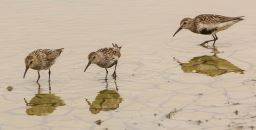Mist-netting - Exminster Marshes - Saturday 13th January 2024
High Tide 3.82m @ 20:19, Sunset 16:09, Rendezvous 15:30
A mixed experience team of 10 assembled at 15:30pm at RSPB Exminster Marshes to set nets around the RSPB lagoon field, on the highest tide of the new moon sequence. It took a while to assemble the team with congestion in the canalside car park, and some team members having advised of late arrivals due to other commitments.
There was a bit more of a northerly breeze than forecast, but it was overcast and the wind was forecast to drop. Based on previous successes this winter, a line of 3 large mesh nets were set on each bund and a line of five 3-panel wader nets were set across the central pool in the same location as in November and December. Water levels were high, and some ares of the main pool were only just navigable in wellies. All nets were set by 16:45 and the team retreated to set up the ringing base and wait for darkness.
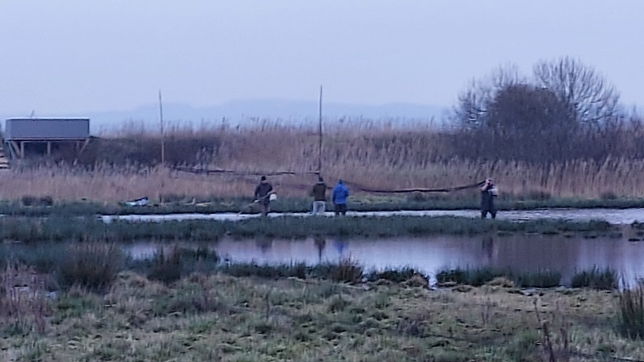 Setting mist-nets on Exminster Marshes © P Perrins
Setting mist-nets on Exminster Marshes © P Perrins
Mist-netting - Exminster Marshes - Friday 15th December 2023
High Tide 3.69m @ 20:22, Sunset 16:09, Rendezvous 14:30
A small team of 9 assembled at 14:30pm at RSPB Exminster Marshes to set around the RSPB lagoon field pools and in King’s Field for a target of Curlew to which to fit satellite tags.
Weather conditions were ideal, 6 degrees with no wind at all 0-5mph, no moon and limited to partial cloud by the end of the session. Continuing wet weather meant pools in RSPB fields were higher than in November and there were several larger pools all wellie height within King’s Field next door.
With a slightly larger and more experienced team nets were set in two locations. A line of 3 large mesh nets were set on each bund in the RSPB fields plus a line of 5 x 3 panel wader nets across the central pool in the same location as November, with these being set by the majority of the team lead by Chris.
In King's Field Ryan and Robbie set two lots of nets, both over water, one longer dogleg of 3 x 18m 2 panel wader nets over the main pool and a single 18m net over a smaller pool nearer the field entrance. Ellie on arrival placed out a selection of Curlew decoys around both net sets in King’s field.
A total net set of 15 nets; 4 in King's field was all set by 16:05pm and 11 in RSPB fields by 16:50pm just as the light started to fade.
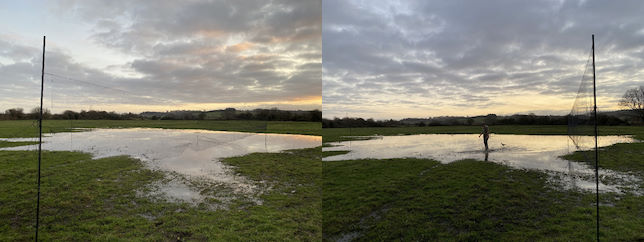 Set mist-nets at Exminster Marshes King's Field © R Phillips
Set mist-nets at Exminster Marshes King's Field © R Phillips
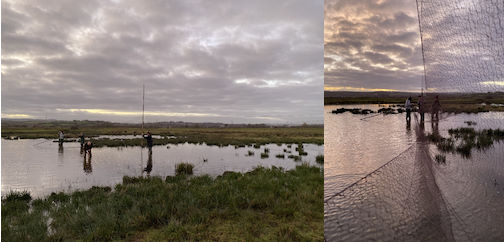 Setting mist-nets at Exminster Marshes RSPB Fields © R Phillips
Setting mist-nets at Exminster Marshes RSPB Fields © R Phillips
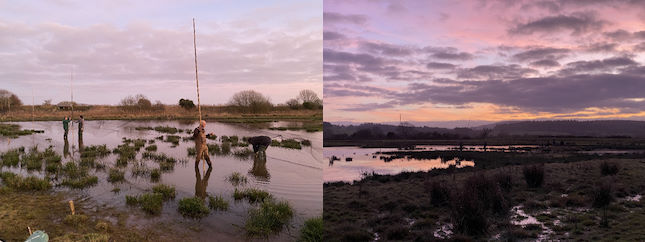 Setting mist-nets at Exminster Marshes RSPB Fields © R Phillips
Setting mist-nets at Exminster Marshes RSPB Fields © R Phillips
Mist-netting - Exminster Marshes - Wednesday 15th November 2023
High Tide 3.76m @ 19:51, Sunset 16:28, Rendezvous 15:00
A small team of 6 assembled at 3pm at RSPB Exminster Marshes to set around the RSPB lagoon field pools. Weather conditions were ideal, with no wind at all 0-2mph, no moon and part to full cloud. Pools were high following a prolonged wet and stormy period but set locations could still be fully accessed with wellies only, just! On arrival a while was spent helping the RSPB wardens move cows out of the field. The 15 cows we has been informed were on site, turned out to be 30 and despite some effort any attempt to move them to a different field failed. Based on this the decision was made to just set one line of 5 full-height 3 panel wader nets across the main pool in a single line running perpendicular to the train line. This was a third of the usual number due to the smaller team size and reluctance to set on either bund due to the cattle. With these all over water, it was hoped the cows would not venture near. All nets were set by 16:30 and the field vacated.
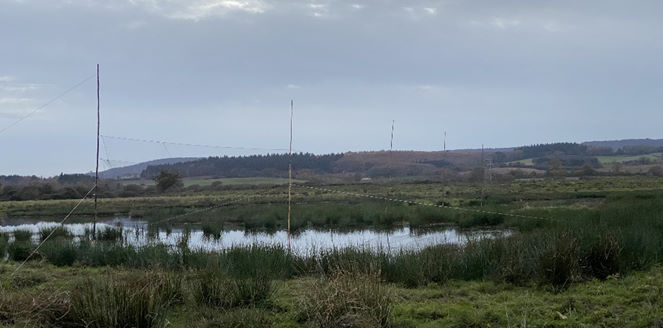 Set mist-nets at Exminster Marshes as the sun sets © R Phillips
Set mist-nets at Exminster Marshes as the sun sets © R Phillips
Aims
The aims of the Devon and Cornwall Wader Ringing Group are to study the wading birds that live in, or pass through, Devon and Cornwall.
We hope to undertake fieldwork approximately once a month, mainly at weekends, involving either mist-netting or the use of a cannon net. Members of the group live across Britain, although many are based in Devon. A key site for fieldwork is the Exe Estuary and in particular Dawlish Warren National Nature Reserve, where we have a project on colour ringed Oystercatcher.
Birds are marked with individually numbered metal leg rings and, to aid relocation without the need to recapture them, with colour rings. Under special license we are also fitting GPS tags to a small number of birds to help understand the way they use the habitats around the estuary through the winter and at different states of the tide.
Links
The Dawlish Warren Recording Group publish regular updates on the birds seen at Dawlish Warren.
The county bird clubs are Devon Birds and the Cornwall Bird Watching and Preservation Society.
Bird ringing in Britain is licensed and coordinated by The British Trust for Ornithology. More information on why we ring birds and why we use colour marks on our study species can be found here. Bird ringing in Europe is coordinated by EURING.
The definitive database of all colour-marking schemes for waders in Europe and the East Atlantic flyway is available on the International Wader Study Group website. All editions of their publications (Wader Study, Wader Study Group Bulletin and International Wader Studies) are available online.
For species other than waders the European colour-ring Birding website, voluntarily maintained by Dirk Raes, should be useful.
Policies
Join us
The group welcomes volunteer ringers from anywhere who are interested in taking part in the fieldwork, although membership of the group is open to all, whether or not you hold a bird-ringing license. Please bear in mind that we need to have a good balance of experience across the team for each session, but we do our best to accommodate and train the less experienced.
The current membership fee is £5 per year, running from November to October. You can register and join here.
Acknowledgements
The group operates with the excellent support of Teignbridge District Council and Devon Wildlife Trust as landowners of Dawlish Warren. Warren Golf Club kindly allow access across their land.
We are also grateful to he RSPB and David King for allowing us to operate on their land at Exminster Marshes and to Torridge District Council for co-ordinating permissions at Northam Burrows.
The value of the projects would not be fully realised without the excellent re-sighting work undertaken and publicised by the Dawlish Warren Recording Group.
We are grateful to Natural England for funding the rings and GPS tags, and for providing staff time for ongoing management of the projects. We are also grateful to the Game and Wildlife Conservation Trust (GWCT) for staff time for fitting the GPS tags, organising the project and dealing with data. Devon Birds have generously provided some funding for colour rings.
Header images on this website are licensed under the Creative Commons license by the photographers.
